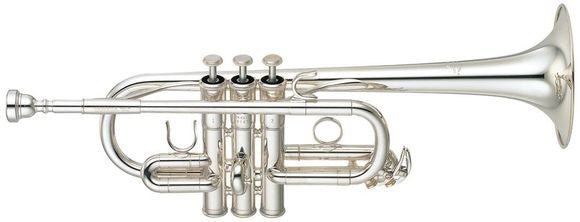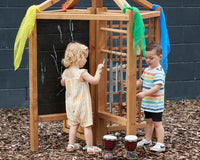 Most people recognise the trumpet as an oblong-shaped length of tubing with a bell at one end and 3 buttons in the middle. Some people recognise the trumpet as the best musical instrument ever invented (these people are called trumpet players or trumpeters...and ignore the opinion of louder, more imposing trombonists!).
Most people recognise the trumpet as an oblong-shaped length of tubing with a bell at one end and 3 buttons in the middle. Some people recognise the trumpet as the best musical instrument ever invented (these people are called trumpet players or trumpeters...and ignore the opinion of louder, more imposing trombonists!).
However, you might not know that there are actually several different types of trumpets, which all look and sound slightly different. This guide will explain some of the different types of trumpets you’ll come across, along with a few unusual ones you might catch a glimpse of once in a blue moon.
Bb Trumpet
Bb Trumpets are by far the most common type of trumpet around. Students through to professional trumpet players around the world play the Bb and it can be seen in practically every Western genre of music, from orchestras, wind bands, big bands, you name it... there'll be a trumpet!
Why are they called a Bb Trumpet? Simply, when a trumpeter plays the note 'C', the pitch that actually comes out of the bell is a concert Bb. So the Bb trumpet is classed as a transposing instrument.
Even with the Bb trumpet, there are many, many different configurations that affect the tone and projection. Different brass alloys are used, from yellow brass (more zinc, less copper for a brighter tone) to gold brass (more copper ratio for a warmer, mellow tone), sizes of bell flare for a focused or wide sound projection, lead pipes, valve alloys (monel being the best) and tuning slides. You name it, there will be the perfect trumpet for you! Some of the best sellers and greatest sounding are: for beginners, the Montreux Student Trumpet and for intermediate to high-end, the Montreux Concert Series.
C Trumpet and Eb/D Trumpet
C trumpets are similar in size and appearance to Bb trumpets. They are sometimes used by classical soloists and orchestral players in situations where certain finger combinations or tuning would be awkward on a Bb, or to make use of the trumpet’s brighter and more direct tonal quality.  Eb/D trumpets are smaller and brighter sounding still than C trumpets. There is a significant difference in the tone of an Eb/D trumpet compared to the Bb. Certain orchestral and solo works are typically performed on the instrument, such as the famous Haydn Trumpet Concerto in Eb.
Eb/D trumpets are smaller and brighter sounding still than C trumpets. There is a significant difference in the tone of an Eb/D trumpet compared to the Bb. Certain orchestral and solo works are typically performed on the instrument, such as the famous Haydn Trumpet Concerto in Eb.
Eb/D trumpets are often equipped with interchangeable slides and sometimes different bells to change between each key.
Piccolo Trumpet
 The smallest member of the trumpet family. Piccolo trumpets are usually pitched in Bb and A, an octave above the Bb, with separate lead pipes to play in both keys. They usually also have a fourth valve which extends the range of the instrument down to a low F#.
The smallest member of the trumpet family. Piccolo trumpets are usually pitched in Bb and A, an octave above the Bb, with separate lead pipes to play in both keys. They usually also have a fourth valve which extends the range of the instrument down to a low F#.
The sound of the Piccolo is much brighter and ‘zingier’ than the Bb and very distinctive. Music from the Baroque era is typically performed on the Piccolo. Famously, the piccolo was used in the instrumental section of Penny Lane by The Beatles.
Pocket Trumpet
 The pocket trumpet is a Bb trumpet where the tubing has been wound more tightly than usual, reducing the instrument’s overall size. The reduced size of the pocket trumpet makes it ideal for taking on holiday or anywhere you need to practice, where the Bb trumpet would be impractical. Talking about portable…
The pocket trumpet is a Bb trumpet where the tubing has been wound more tightly than usual, reducing the instrument’s overall size. The reduced size of the pocket trumpet makes it ideal for taking on holiday or anywhere you need to practice, where the Bb trumpet would be impractical. Talking about portable…
Other Trumpets
Although rare, trumpets in other keys such as E, F and G do exist. These trumpets are occasionally called for in classical repertoire, though it’s typical for trumpet players to simply transpose the part and play it on a more common trumpet.
The vast majority of trumpets in the UK and USA are built with piston valves and their rotary valve cousins are seldom seen. These instruments have gained more popularity in Germany and Eastern Europe.
The turn of the 19th century saw the invention of a keyed trumpet; before valves were added to change the pitch. This allowed the player to use all the notes of the chromatic scale, but it was difficult to play. The inferior tone saw it fall quickly out of popularity after the invention of valves.
Another type of trumpet is the bass, which was invented in the early 1800s. The bass trumpet has appeared in a handful of classical works but has never become a mainstay of the orchestral brass section. The instrument is similar to a valve trombone, with a comparable mouthpiece but set up in a trumpet configuration.
An even lower-sounding member of the trumpet family, the contrabass, has been made in the past. These are so rare as to be considered more of a novelty than a regular member of the brass section.
As you can see, there are lots of different types of trumpet; I hope this guide has helped you to understand them a little better. So there you have it, more trumpets than you can shake a (conductors) stick at (not that a trumpeter would be watching the conductor!!).
If you still need any advice, simply get in contact with us here at Normans Musical Instruments.




















